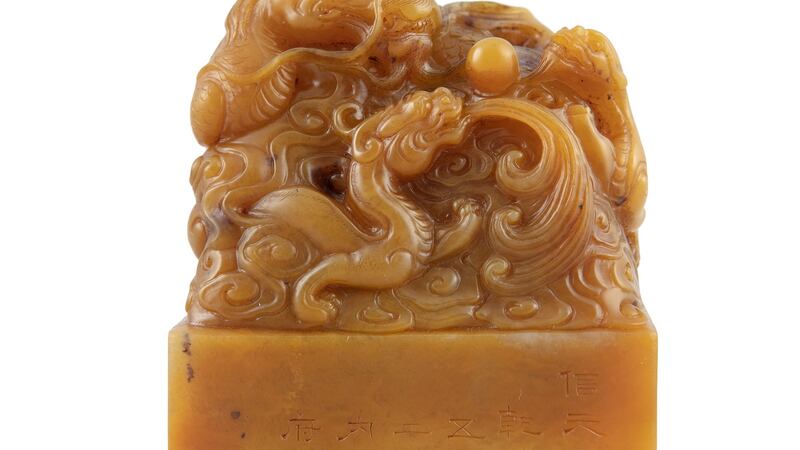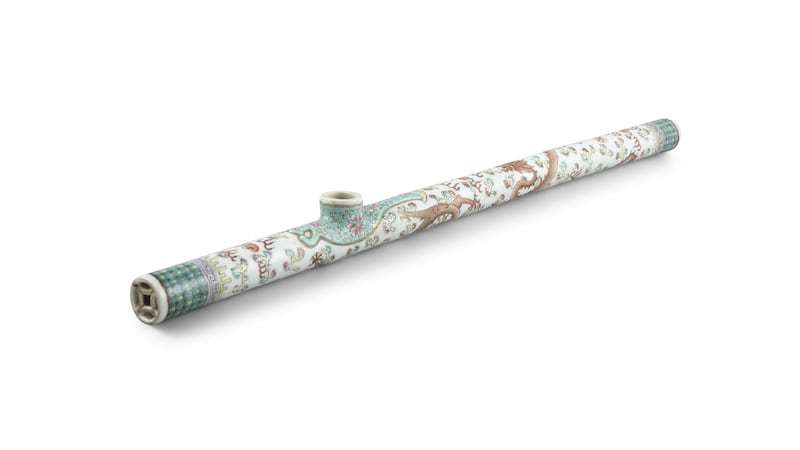Adam’s Asian Art sale on Tuesday, November 5th will feature almost 200 lots from China, Japan, India, Nepal and Tibet.
Included along with important porcelain and furniture, is an inscribed and dated Tianhuang imperial seal from the Qianlong period (1736-1795). The 1787 seal bears the inscription: “The master of heaven Qianlong made by the house of internal affairs.”
Chinese seal carvings are an ancient art that combines calligraphy and engraving, used as a personal signature of their owner, or more significantly, as the symbol of legitimacy for a ruler. Regulations existed as to the material used and shape of the handle of these seals, or chops as they are also known.
Up to the Han dynasty, the colour of ink used to affix official seals was regulated depending on the position of each official. The ranking system placed yellow as the emperor’s colour and it is the symbolic colour of the five legendary emperors of ancient China. Here the use of yellow from the Tianhuang stone, which translates as “heavenly yellow” is also symbolic of heroism, as opposed to the western association of the colour with cowardice.

The house of internal affairs or the imperial household department, with which this seal is stamped, was an institution in the Qing dynasty that managed the affairs of the Qing imperial family, and the seal dedicated to the emperor was “presumably presented as a gift on behalf of the institution” according to the catalogue, €20,000-€30,000.
As expected, porcelain features significantly in the sale. What is described as a “fine Chinese celadon glazed double gourd vase” also from the Qianlong period is seeking €30,000-€40,000.
Another piece of rare Chinese porcelain is the inscribed pink ground famille rose tea tray, 1796-1820. The shallow quatrefoil-shaped tray is inscribed with an imperial poem relating to the preparation of tea (€20,000-€30,000).
In the mid-1800s when the newly-acquired taste for tea saw huge sailing ships import the leaves from China to satisfy the demand, the second largest cargo aboard these ships was the drug opium. In 1860, more than 127,000kg of the narcotic was imported to England as ordinary cargo.
Queen Victoria's inner circle ordered opium from the royal apothecary, and she is also believed to have taken cocaine gum with a young Winston Churchill. William Gladstone is said to have taken opium in tea or coffee before making important speeches.
In China and Britain the drug was consumed by all classes. The legendary opium dens saw it used recreationally, as told by Oscar Wilde in The Picture of Dorian Gray: "There were opium dens where one could buy oblivion, dens of horror where the memory of old sins could be destroyed by the madness of sins that were new."
For the well-heeled who took the narcotic in their own homes, the decorative arts at the time addressed the need for fine objects which could be used to enhance the user experience.

During the height of the opium trade hundreds of tools were finely crafted specifically for the preparation and ingestion of the drug, such as the late 19th-century famille rose opium pipe, €150-€200, and the Qing dynasty reclining opium chair, €1,000-€1,500, both featured in the Adam's sale. See adams.ie
Kildare contents
Some interesting treasures in this week’s sales include the entire contents of Castlesize in Sallins Co, Kildare which recently sold for €2.7 million. The sale, by auctioneer Sean Eacrett of more than 580 lots, will take place on Tuesday, November 5th.
Castlesize was the home of former champion jockey Liam Ward, who rode for trainer Vincent O'Brien, in a celebrated career that saw him bring the famous Nijinsky to victory in 1968, a ride he described as "an absolute steering job".
As one would expect equine interests feature strongly in the sale along with art, furniture and racing ephemera.
Chief among them is the 50cm-high bronze by Judy Lynch of Nijinsky with Ward in the saddle, (€400-€600), along with the 1959 Sheffield silver champion jockey trophy and photo of Ward receiving the cup from then taoiseach Seán Lemass (€300-€500). Two more champion jockey silver trophies are also on offer.
Another highlight is a large oil painting by prominent Irish landscape painter Bartholomew Colles Watkins RHA (€4,000-€6,000) of an autumnal pastoral scene. See seaneacrettauctions.ie




















